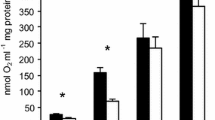Abstract
The thermal sensitivity of mitochondrial function was investigated in the stenothermal Antarctic fish Lepidonotothen nudifrons. State 3 respiration increases with increasing temperature between 0 °C and 18 °C with a Q 10 of 2.43–2.63. State 4 respiration in the presence of oligomycin, an inhibitor of mitochondrial ATP synthase, quantifies the leakage of protons through the inner mitochondrial membrane, which causes oxygen consumption without concomitant ATP production. This parameter shows an unusually high Q 10 of 4.21 ± 0.42 (0–18 °C), which indicates that proton leakage does not depend merely on ion diffusion but is an enzyme-catalysed process. The differential thermal sensitivity of oxidative phosphorylation (=state 3) and proton leakage (=state 4 in the presence of oligomycin) leads to progressive uncoupling of the mitochondria and decreased efficiency of oxidative phosphorylation under in vivo conditions if the body temperature of L. nudifrons increases.
Similar content being viewed by others
Author information
Authors and Affiliations
Additional information
Accepted: 2 September 1999
Rights and permissions
About this article
Cite this article
Hardewig, I., Pörtner, H. & Peck, L. Thermal sensitivity of mitochondrial function in the Antarctic Notothenioid Lepidonotothen nudifrons . J Comp Physiol B 169, 597–604 (1999). https://doi.org/10.1007/s003600050260
Issue Date:
DOI: https://doi.org/10.1007/s003600050260




